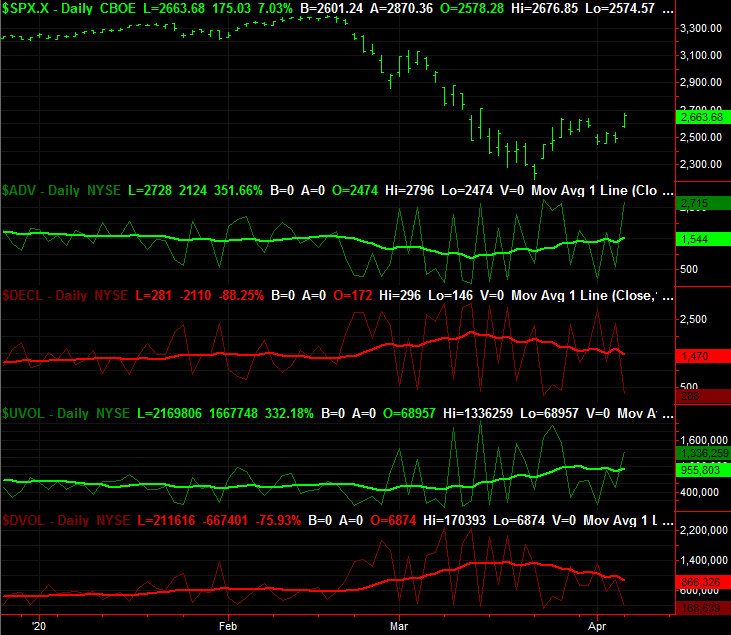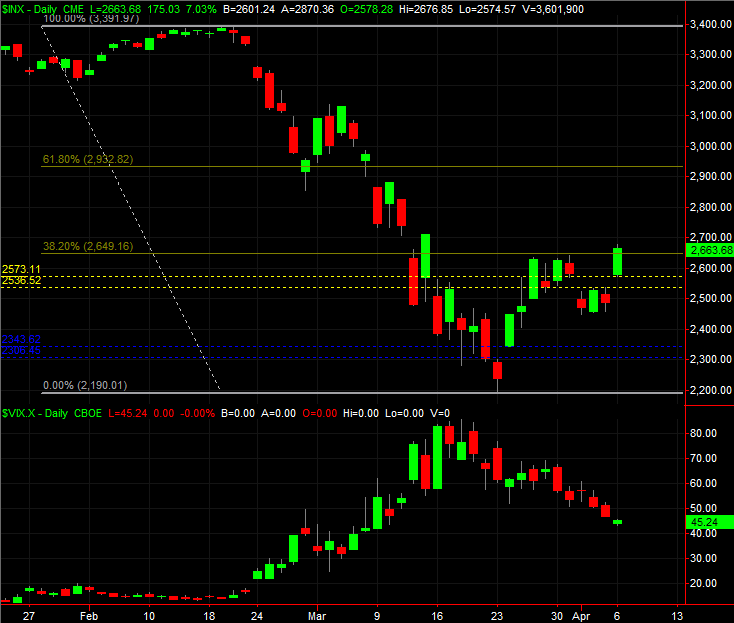The Good News (And Bad News) About Monday's Surge
Not surprisingly, a little progress on the coronavirus front went a long way with investors. While the number of national and global cases continues to rise, the pace of that spread is seemingly slowing. That portends an eventual end to the contagion, and traders being traders, they'd rather take the chance on being too early than missing out. With that as the backdrop...
There's no doubt Monday's buyers are serious. The volume behind the move was the highest since the March 26th gain, and bullish volume ($UVOL) has been slowly building for a few days. Conversely, the bearish volume ($DVOL) for the day's losers was the lowest since March 24th and has also been trending downward for quite some time. In the meantime, the total number of NYSE advancers ($ADV) almost eclipsed the big number hit on March 24th, while the total number of declining stocks ($DECL) almost matched the low reading from March 24th. Again, both advancers and decliners only extended existing, budding trends, but those trends accelerated today.
(Click on image to enlarge)

In short, more and more people really are getting on board, believing this new effort is going somewhere.
That's not the only reason investors and traders have a decent reason to be excited here. Additionally, thanks to Monday's late-in-the-day push, the S&P 500 managed to clear a major Fibonacci retracement line that has previously capped the rally effort a week ago.
The chart below lays out the graphic details. The 2649 level is a perfect 38.2% Fibonacci retracement of the selloff from February's high to March's low. The likely ceiling turned into an actual ceiling for the rebound effort seen in late March, setting up last week's lull. The resistance line could keep the buying contained on Monday though, with the S&P 500 closing at 2663.68.
(Click on image to enlarge)

Still, the rebound effort thus far is plagued with a few but sizeable problems. Chief among them is the fact that there are now not one but two gaps in the rearview mirror. The latter of them was made on Monday, framed by yellow dashed lines on the chart above. The other one took shape on -- you guessed it -- March 24th, which is the day after the S&P 500 hit a multi-month low and started to hint at a reversal by rallying back before the close on the 23rd. That gap is framed with blue dashed lines.
Simply put, traders don't like to leave gaps behind, unfilled, so they'll frequently do what it takes to go back and fill them in before proceeding. It's not accurate to say every gap eventually gets filled (or even filled in shortly after being made), but a lot of them do... too many to simply dismiss this one.
On the other hand, if there was ever a set of unusual circumstances that would allow a gap to remain comfortably unfilled, we're seeing them right now. This market crash hasn't necessarily coincided with a cyclical downturn. It was induced by a sudden and unexpected standstill of global commerce. Around 4 million people are suddenly out of work, but they may be able to return to a job or quickly find a new one once the contagion is contained. Or, the standstill thus far just might linger long enough to start a recession, which will crimp earnings as well as jobs. Monday's big gain largely says traders are looking for the former rather than the latter.
Let's hope their right. That said, let's also assume nothing until Monday's advance is tested and we can see what traders do with the gap they left behind. In some ways, the best thing for the market here would be a sizeable step back to fill in Monday's gap followed by another strong advance that carries the S&P 500 above the Fibonacci retracement line at 2649. That would largely validate the bullish effort we're seeing unfurl here, and inspire more people to step into it... fueling it.




Mondays tend to be good Fridays Bad during periods of dynamic change. Unless they follow, be careful reading too much into them.
Hey, I'll take whatever good news I can get.